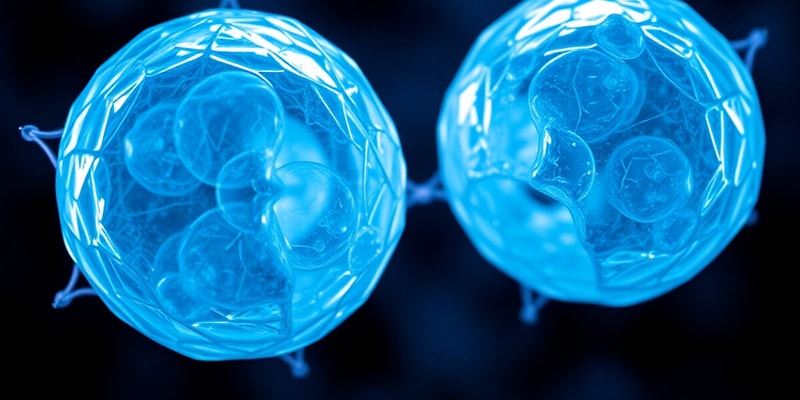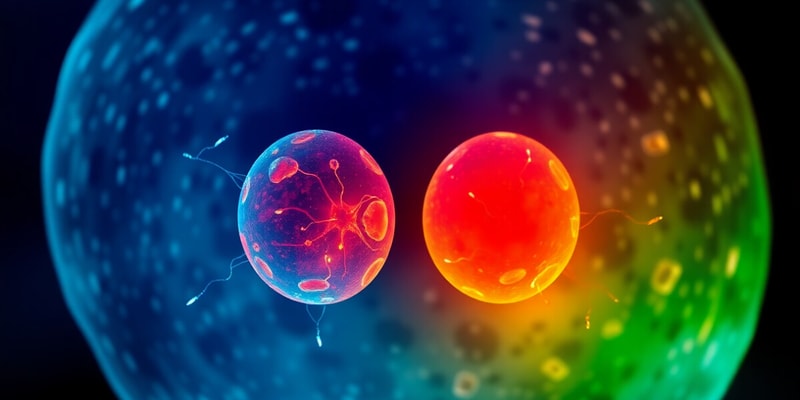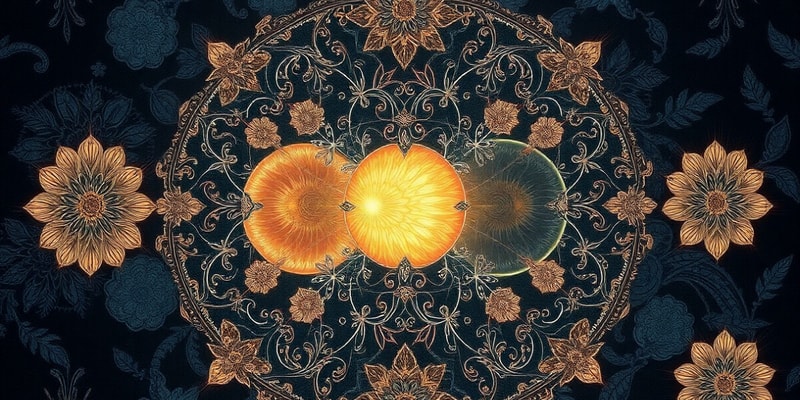Podcast
Questions and Answers
What is the primary difference in the orientation of kinetochores between meiosis I and meiosis II?
Which of the following correctly describes the DNA content at the end of meiosis I?
In human reproduction, what is the purpose of meiosis?
What type of life cycle do humans have regarding meiosis?
Signup and view all the answers
What occurs during meiosis II that distinguishes it from mitosis?
Signup and view all the answers
What is the DNA content of a cell immediately after the S phase before meiosis begins?
Signup and view all the answers
Which statement about the chromosome number during meiosis is correct?
Signup and view all the answers
What is true about the starting cell for meiosis compared to the starting cell for mitosis?
Signup and view all the answers
During which phase of meiosis do homologous chromosomes separate?
Signup and view all the answers
How many chromosomes are present in a human somatic cell before meiosis begins?
Signup and view all the answers
What is the primary result of meiosis II?
Signup and view all the answers
How many haploid sperm cells are produced from one spermatogonium?
Signup and view all the answers
Which process contributes to genetic diversity during meiosis?
Signup and view all the answers
In humans, what is the approximate number of combinations that can occur due to independent assortment?
Signup and view all the answers
At what stage does recombination begin during prophase I of meiosis?
Signup and view all the answers
What is the fate of the polar bodies produced during oogenesis?
Signup and view all the answers
What is the expected outcome of nondisjunction during meiosis II?
Signup and view all the answers
What factor is most commonly associated with nondisjunction in human females?
Signup and view all the answers
Which statement about the synaptonemal complex is true?
Signup and view all the answers
What is the primary consequence of a nondisjunction event in meiosis I?
Signup and view all the answers
What initiates meiotic recombination?
Signup and view all the answers
What is the primary model thought to occur for non-crossover recombinants?
Signup and view all the answers
What does meiosis I primarily accomplish?
Signup and view all the answers
What type of lifecycle in humans requires meiosis?
Signup and view all the answers
What are the two phases of meiosis?
Signup and view all the answers
What is a common consequence of nondisjunction during meiosis?
Signup and view all the answers
Which process primarily contributes to genetic diversity in meiosis?
Signup and view all the answers
What distinguishes meiosis from mitosis?
Signup and view all the answers
What is the outcome of meiosis II?
Signup and view all the answers
What effect does maternal age have on eggs during meiosis?
Signup and view all the answers
What is the primary purpose of meiosis in humans?
Signup and view all the answers
During which phase of meiosis do sister chromatids begin to separate?
Signup and view all the answers
Which statement describes the chromosome state immediately after meiosis I?
Signup and view all the answers
Which lifecycle is associated with fungi in relation to meiosis?
Signup and view all the answers
How do the kinetochores of sister chromatids behave in meiosis I compared to meiosis II?
Signup and view all the answers
In the context of meiosis, what does the 'N' in 2N and 4N represent?
Signup and view all the answers
What is a significant difference between mitosis and meiosis regarding chromosome number?
Signup and view all the answers
What happens to the chromosome number during the S phase before meiosis?
Signup and view all the answers
Which of the following processes primarily increases genetic diversity during meiosis?
Signup and view all the answers
What characterizes a sporic lifecycle in plants regarding meiosis?
Signup and view all the answers
What is the primary result of recombination during meiosis?
Signup and view all the answers
What initiates the meiotic recombination process?
Signup and view all the answers
What is the expected outcome of nondisjunction during meiosis I?
Signup and view all the answers
Which model is primarily associated with crossover recombinants during meiosis?
Signup and view all the answers
During which phase does crossing over occur?
Signup and view all the answers
How many haploid cells result from the division of one oogonium?
Signup and view all the answers
What is the main outcome of meiosis I?
Signup and view all the answers
What facilitates crossing-over but is not required for the process?
Signup and view all the answers
Which phase of meiosis closely resembles mitosis?
Signup and view all the answers
How does maternal age affect the risk of errors during meiosis?
Signup and view all the answers
Which statement about genetic diversity during meiosis is accurate?
Signup and view all the answers
What are the two major types of recombination outcomes in meiosis?
Signup and view all the answers
What is the primary consequence of nondisjunction during meiosis II?
Signup and view all the answers
Which term describes the failure of chromosomes to separate properly during meiosis?
Signup and view all the answers
Which lifecycle in humans requires meiosis for the production of gametes?
Signup and view all the answers
How many combinations of chromosome separation are possible in humans due to independent assortment?
Signup and view all the answers
What is a fundamental process that increases genetic diversity during meiosis?
Signup and view all the answers
Which phase marks the breakdown of the nuclear envelope during meiosis?
Signup and view all the answers
What is the primary consequence of nondisjunction during meiosis?
Signup and view all the answers
Which mechanism primarily deals with non-crossover recombinants in meiosis?
Signup and view all the answers
Study Notes
Meiosis I and Meiosis II
- Meiosis I separates homologous chromosomes, transitioning from diploid to haploid cells.
- Meiosis II separates sister chromatids, similar to mitosis.
- Kinetochores of sister chromatids point in the same direction during meiosis I but opposite directions during meiosis II.
Life Cycles: Gametic, Zygotic, and Sporic
- Humans possess a gametic lifecycle, where meiosis generates haploid gametes. Most human cells are diploid.
- Fungi exhibit a zygotic lifecycle. They are typically haploid organisms, and meiosis restores this state after diploid zygote formation.
- Plants have a sporic lifecycle involving a diploid sporophyte stage that undergoes meiosis to produce haploid gametophyte forms.
Mitosis vs. Meiosis
- Mitosis duplicates cells, maintaining the chromosome number.
- Meiosis creates haploid cells from diploid cells. In humans, this process is exclusively used for gamete production (sperm and eggs).
Chromosome Dynamics in Mitosis and Meiosis
- Human cells are diploid (2N), containing 46 chromosomes arranged in homologous pairs.
- After DNA replication (S phase), the DNA content becomes 4N*, indicating duplicated chromosomes with sister chromatids.
- Mitosis restores the original 2N condition, resulting in two diploid cells.
- Meiosis starts with 2N DNA content, which becomes 4N* after S phase.
- Meiosis I separates homologous chromosomes, leading to two haploid cells with 2N* DNA content (23 chromosomes).
- Meiosis II separates sister chromatids, generating four haploid cells with 1N DNA content.
Gamete Formation in Humans
- One spermatogonium produces four haploid sperm cells.
- One oogonium generates only one haploid egg, with the other cells becoming polar bodies that degrade.
Genetic Diversity in Meiosis
-
Independent Assortment: Homologous chromosomes separate randomly during anaphase I, leading to numerous combinations (2^N, where N is the number of chromosome pairs).
- In humans (N=23), there are approximately 8 million possible combinations.
- Recombination (Crossing Over): Homologous chromosomes exchange fragments, creating chimeric chromosomes. This occurs during prophase I, starting in leptotene and ending in diplotene.
Synaptonemal Complex
- This structure facilitates crossing over, but it's not absolutely necessary.
- It consists of chromatin, axial elements, cohesin, and various factors facilitating recombination.
Nondisjunction
- This abnormal event in meiosis leads to aneuploidy (daughter cells with the wrong chromosome number).
- Meiosis I nondisjunction results in four abnormal gametes: two with an extra chromosome, two missing a chromosome.
- Meiosis II nondisjunction leads to two normal gametes, one with an extra chromosome, and one missing a chromosome.
- In human egg formation, there is a 50% chance of an egg with an extra chromosome and a 50% chance of missing a chromosome.
- Nondisjunction is more frequent in meiosis I of human egg formation, linked to the mother's age.
- Eggs remain in prophase I for a long time, increasing the risk of errors with age.
Meiotic Recombination Model
- It involves a double-strand break or gap, followed by pairing with a homologous chromosome and strand invasion.
- This initiates recombinational repair, potentially leading to crossover (CO) or non-crossover (NCO) of flanking regions.
- CO recombination is thought to occur through the Double Holliday Junction (DHJ) model.
- NCO recombination is believed to primarily occur through the Synthesis Dependent Strand Annealing (SDSA) model.
- Most recombination events appear to be of the SDSA type.
Fundamental Points
- Meiosis occurs in two phases: Meiosis I and Meiosis II with defined steps.
- Meiosis I separates homologous chromosomes, producing haploid daughter cells.
- Meiosis II, similar to mitosis, separates sister chromatids.
- Lifecycles vary in the role of meiosis: gametic (humans), zygotic (fungi), and sporic (plants).
- By tracking chromosome numbers, DNA content, and diploid/haploid status, one can compare mitosis and meiosis.
- Independent assortment and recombination contribute to genetic diversity in meiosis.
- Errors in meiosis can lead to nondisjunction.
Meiosis Phases
- Meiosis I separates homologous chromosomes, transitioning cells from diploid to haploid.
- Meiosis II, similar to mitosis, separates sister chromatids.
- Both meiosis I and II involve prophase, prometaphase, metaphase, anaphase, and telophase stages.
- In meiosis I, sister chromatids' kinetochores point in the same direction, while in meiosis II, they point in opposite directions. This difference reflects the distinct separation processes in each phase.
Lifecycles Types
- Humans have a gametic lifecycle. Meiosis produces haploid gametes, but most human cells are diploid.
- Fungi have a zygotic lifecycle. Fungi are typically haploid. Meiosis restores the haploid form after fertilization creates a diploid zygote.
- Plants have a sporic lifecycle. A diploid sporophyte form undergoes meiosis to produce a haploid gametophyte form.
Mitosis vs. Meiosis
- Mitosis duplicates cells while maintaining the chromosome number.
- Meiosis generates haploid cells from diploid cells, essential for gamete formation in humans.
Chromosome and DNA Content
- Human cells are diploid with 46 chromosomes (2N).
- After S phase, DNA content is 4N*.
- Mitosis restores the 2N condition, producing two identical diploid cells.
- Meiosis starts with 2N DNA content, replicates to 4N*, then separates homologous chromosomes in meiosis I, resulting in two cells with 2N* content.
- Meiosis II separates sister chromatids, yielding four haploid cells with 1N DNA content.
Gamete Formation
- One spermatogonium generates four haploid sperm cells during meiosis.
- One oogonium produces one haploid egg, while other cells become polar bodies that disintegrate.
Genetic Diversity in Meiosis
- Independent assortment during meiosis I creates genetic diversity. Homologous chromosomes can separate in multiple combinations (2^N).
- Recombination (crossing over) exchanges fragments between homologous chromosomes, resulting in chimeric chromosomes.
- Crossing over occurs during prophase I, specifically during leptotene, zygotene, pachytene, diplotene, and diakinesis.
Synaptonemal Complex and Nondisjunction
- The synaptonemal complex facilitates crossing over, but is not strictly necessary.
- Nondisjunction is an abnormal event in meiosis that produces daughter cells with an incorrect chromosome number (aneuploidy), leading to genetic disorders.
- Nondisjunction in meiosis I produces four abnormal gametes.
- Nondisjunction in meiosis II produces two normal and two abnormal gametes.
- Nondisjunction in egg formation occurs during meiosis I and is associated with maternal age, especially Down's Syndrome.
Meiotic Recombination Model
- Modern models propose that meiotic recombination is initiated by a double-strand break, followed by pairing with a homologous chromosome and strand invasion.
- This process can lead to crossovers (CO) or non-crossovers (NCO) of the flanking regions. CO recombination is thought to occur via the Double Holliday Junction (DHJ) model, while NCO recombinants primarily occur by the Synthesis Dependent Strand Annealing (SDSA) model, with SDSA being more common.
Fundamental Points
- Meiosis progresses through two distinct phases: meiosis I and meiosis II.
- Meiosis I separates homologous chromosomes, resulting in haploid daughter cells.
- Meiosis II is similar to mitosis and separates sister chromatids.
- Lifecycles vary, with differences in the role of meiosis: gametic (humans), zygotic (fungi), and sporic (plants).
- Tracking chromosome numbers, DNA content, and diploid/haploid status helps understand mitosis and meiosis.
- Independent assortment and recombination generate genetic diversity during meiosis.
- Nondisjunction refers to errors in meiosis that produce abnormal chromosome numbers.
Studying That Suits You
Use AI to generate personalized quizzes and flashcards to suit your learning preferences.
Related Documents
Description
Explore the intricate processes of meiosis I and II, and how they differ from mitosis. This quiz covers life cycles in humans, fungi, and plants, emphasizing the transition from diploid to haploid cells. Test your understanding of chromosome dynamics and reproductive strategies in various organisms.




